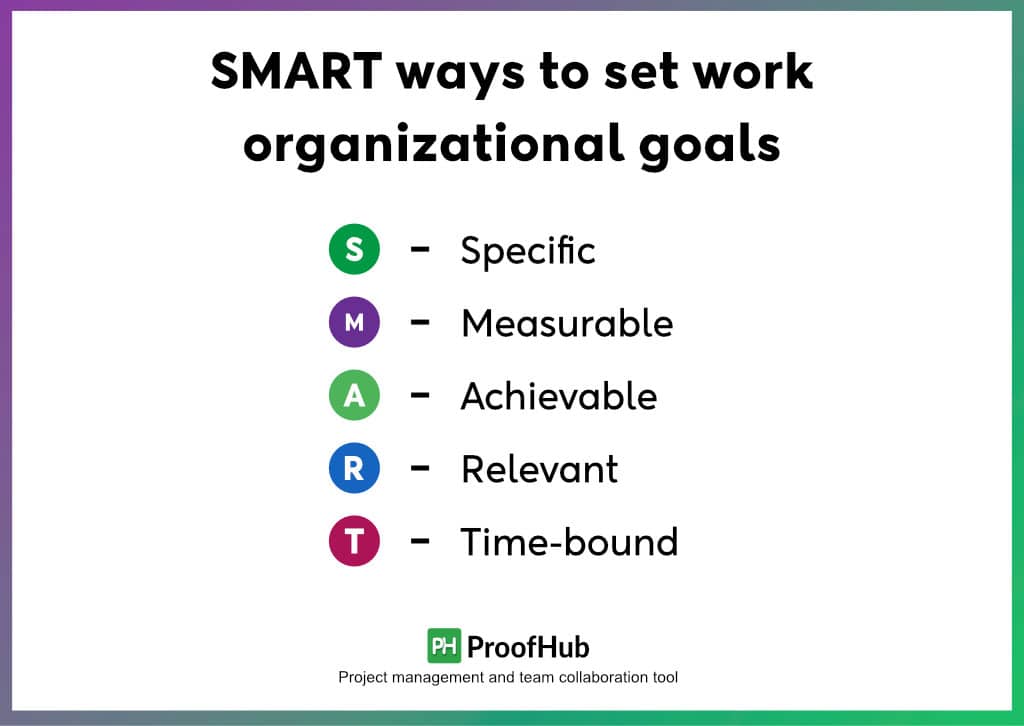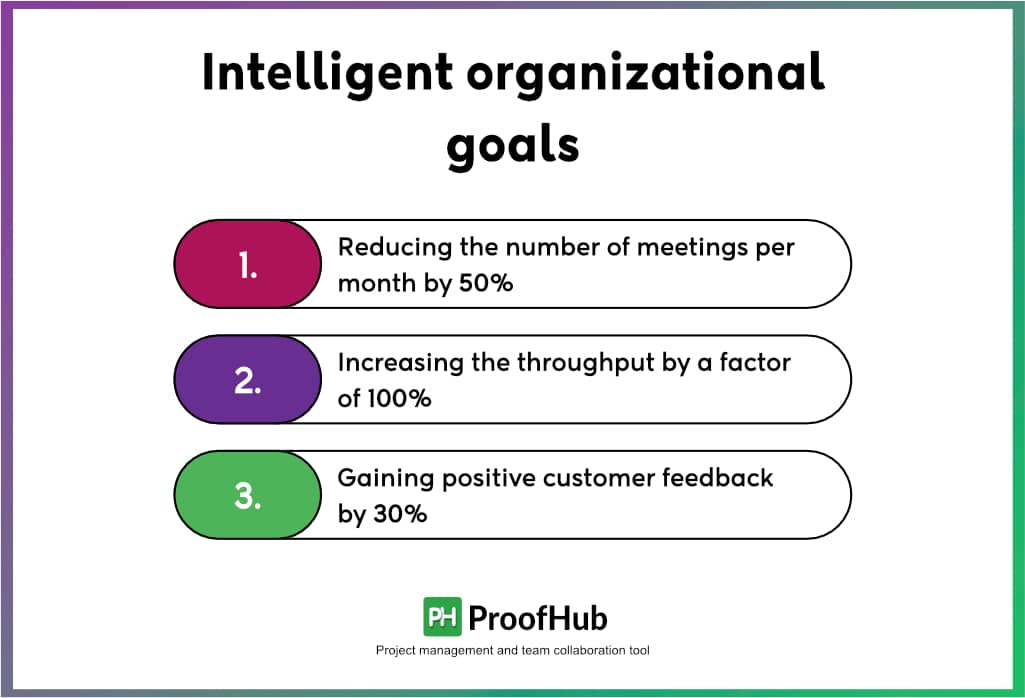Introduction
“Coming together is a beginning. Keeping together is progress. Working together is success.” — Henry Ford
The real indicator of management failure is not realizing what you can achieve with the collective efforts of your team. This is why, early on, you must set some ground rules and some definitive organizational goals so that your team has a direction to work in and an achievement to look forward to.
Are we ready to do that? As you will understand in this article, setting work organizational goals is imperative for your organization’s growth and success.
What are organizational goals?
Organizational goals are strategic objectives that a company aims to achieve. These goals provide a direction and purpose, helping teams to align their efforts to meet the specific targets.
The well-defined organizational goals ensure every department works toward the same goal, offering strategic planning, decision-making, and operational alignment to the teams.
If you are in a leadership position, I think you would agree that there are some things that you consider goals. And, these are some of the aspects that form the foundation of the work culture at an organization. These are principles and goals that you want your whole team to be on board with.
Why organization-wide goals are important for business?
Organizational goals are a roadmap for organizations to follow. It is essential for businesses because they provide a clear direction and purpose, ensuring that every team member is aligned and working towards common objectives. These goals promote a sense of unity and collaboration, helping to streamline efforts and resources toward achieving the business’s vision. By setting organizational goals, you can:
1. Aligned focus and direction: Work organization goals offer a roadmap for your business, guiding decisions and actions at every level. Goals help align efforts across different departments, ensuring everyone works toward a common objective.
2. Motivation and engagement: When employees understand the bigger picture and how their roles contribute to it, they are more motivated and engaged. Clear objectives inspire teams and give them a sense of purpose.
3. Performance measurement: Goals can be used as a benchmark for analyzing the performance of the initiatives taken by the organization and identifying the areas for improvement.
4. Strategic growth: It serves as a roadmap for the growth and success of the organization.
5. Improve performance and accountability: Clear goals set expectations, making measuring performance easier and holding team members accountable.
6. Facilitate better resource allocation: With defined goals, you can allocate resources more effectively, ensuring that time, money, and effort are invested in the right areas.
By prioritizing work organizational goals, you create a strong foundation for sustainable growth, innovation, and long-term success.
SMART ways to set work organizational goals

There are some parameters to set organizational goals that must be discussed before we choose our cut of some much-needed objectives. The criteria to set these goals is quite simple and yet very SMART.
Here’s what SMART stands for when you talk about setting some reasonable organization-wide goals:
1. Specific
Here’s something that organizational goals are not; they are not vague. If you really want to achieve something, having the whole team back you, you need the end outcome to be as specific as possible.
Here’s an example; Where “I want us to step up our branding game” sounds like a pipedream, “I want us to create at least 30 backlinks this week”, sounds like a real objective.
Since the 2nd example comes with a well-defined course of action, it is more likely to get accomplished. Hence, these goals should be foreseeable, quantifiable, and as specific as possible. Only specific goals can give your team the hope that these goals are achievable.
2. Measurable
Concrete goals that can be melted down to specific numbers are the kind of goals your team will be motivated to achieve. The idea is to set goals that help define and track progress. This helps determine how far the team has come and how far they have yet to go.
For example, If the target is for the team to generate 30 backlinks per week, then I would check that number against the outcome of Friday, every week.
These measurable and trackable targets work best with a proficient project management software platform that can help you be on top of everything, absolutely every step of the way.
3. Attainable
So now we have determined that these goals need to be specific and measurable, trackable and clear, we have to discuss another very real aspect of defining said objectives. The aspect in question is the attainability of the goal itself.
If I am expressing to my team the interest in attaining 30 backlinks every week, then I must be sure that this goal is actually achievable. A team of, say, 2 professionals, won’t be able to achieve these sorts of targets, and hence, would eventually fail.
Failing, that too, failing consistently, can be demoralizing for your team. It would hamper the overall motivation with which the team tries so hard to work. Therefore, these organizational goals must be attainable.
4. Realistic
Now attainable is one thing, and realistic is another. For example, an overzealous newbie manager is likely to set unrealistic goals that are closer to fiction than to fact.
Realistic goals help maintain morale within the team. These give the employees a sense of achievement as well as a sense of satisfaction when they can accomplish a certain feat with all of their efforts.
Everyone is bound to get tired of a manager who doesn’t know the limitations and strengths of their team. It gives the team a sense that the manager does not know them or the work. This can make them feel alienated and accountability could take a turn for the worse.
5. Time-based
“Goals are dreams with deadlines.” ― Diana Scharf
You want results so you define goals with the utmost clarity, however, you don’t tell your team when exactly you want them to achieve these goals. What do you think happens next
The team is bound to forget about these defined rules, and eventually, would start working at their usual pace. This would, in the long run, drive the organization even further away from achieving the organization-wide goals.
Hence, deadlines, though a little negative and a teensy bit overbearing, can help you define a more realistic, reasonable, time-based approach to achieving these company-wide goals.
Intelligent organizational goals you must adopt as your own
Let’s discuss some examples of smart goals that your whole organization would be ready to get behind, and consequently, follow.

1. Reducing the number of meetings per month by 50%
Here’s why this is a great idea for a work organizational goal:
Meetings, although a good source of keeping the whole band together, can also be a colossal waste of time. Meetings, without a direction and an agenda, could turn into a never-ending discussion with no concluding remarks.
We don’t want that, do we?
Now, if you think meetings are what keeps your team together, keep you all on the same page, and keep everyone informed of the collective progress of the team, you might not be 100 percent right.
You see, there are a lot of alternatives to meetings. These alternatives will, in turn, help you reduce the frequency and number of meetings you think are imperative to the health of your project.
- If tracking progress is what you want from a meeting, there are a lot of tracking tools out there that can help you streamline that process. Want to keep an eye on how your employees are making use of their time, want to see what tasks they spend most of their time on, and want to determine accurate performance analytics? It’s all possible through a reliable tracking tool.
- If brainstorming ideas is what you want from a meeting, note-keeping tools or task management tools that offer “Discussions” can help you out. These tools help in actively documenting your ideas, and organizing them based on priority. If you had trouble concluding brainstorming meetings before, I assure you, that you won’t anymore.
- If sharing updates is what you want from a meeting, a project management software platform would suffice all your needs with ease. A tool, such as ProofHub, for example, can help teams send timely notifications and share updates across platforms with a few clicks of a button.
2. Increasing the throughput by a factor of 100%
Throughput is defined as a number of deliverables that a team can prepare in a given time. If I am generating, say, 50 backlinks in a month, that is my throughput for that particular time.
Now if I want to raise my throughput by a factor of 100%, which is a specific, measurable, and time-based goal, my team needs to undertake certain practices.
These practices must include:
- Organizing files and documents: People like to believe that things being sorted and organized is an overrated regimen, however, that couldn’t be farther from the truth. Having an organized inventory of data ensures time efficiency.
- Having a functional workflow: Workflows can help teams save a lot of time, and, subsequently, be way ahead of schedule all the time. These help keep the team together, give a clear idea of every task’s progress, and help everybody be in the loop 24×7.
- Communicating clearly: To increase productivity, you need to clear the airwaves. There should be no gaps in communication, no misunderstandings, and no confusion. You must define clear pathways and dedicated channels for communication that can help your team stay on the same page all the time.
3. Gaining positive customer feedback by 30%
Another great objective for a team to collectively work towards could be one where you increase your chances of overall success, and hence, rating of your product or services. This can happen only when the testing and reviewing part of your process is strong.
For this, you need three things:
1. A well-defined workflow:
- To ensure that everything is in order
- To actively track all ongoing processes.
- To ensure that no stage in the work process gets skipped.
2. Transparent work culture:
- Keep all communication channels functional.
- Use smart file and document-sharing programs to keep the team in the loop.
- Use project management tools that can help you communicate, share information, and review files all on the same platform.
3. Proofing tools:
- These will help your team store multiple versions of the same document.
- These will help make feedback more actionable with annotation and mark-up features.
- These tools help approve files digitally, therefore maintaining clarity even when teams work from home.
What are some examples of organizational goals?
Example 1
Increase revenue by 20% within one year.
In this case, the objective would be to enhance the company’s financial performance through strategies like entering new markets, running targeted marketing campaigns, and offering attractive promotions and offers. Achieving this objective strengthens the organization’s financial position and provides the resources needed for future growth.
Example 2
Improve employee retention by 15% over the next two quarters. The objective would be to reduce turnover by creating a positive work environment where employees feel valued and engaged. The Strategies may include implementing employee recognition programs, providing skills development opportunities, and conducting regular feedback sessions. This goal benefits the organization by reducing the costs and disruptions in workflow caused by frequent hiring and training.
Conclusion
Organizational goals are more than necessary for an organization to flourish and prosper. These goals are what keep the whole team productive and agenda-driven.
These goals are what make a team motivated and engaged at all times. This is why if you haven’t had a set of organization-wide goals till now, it’s time to think about some right now.
ProofHub can help you set and achieve these organizational goals effectively. With its comprehensive project management features, ProofHub allows you to create, assign, and track goals, ensuring that every team member is aligned with the organization’s objectives.
Start using ProofHub today to streamline your workflow and drive your organization toward success.
Related articles

